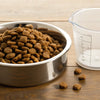How Much Food Should I Feed My Dog by Weight: A Comprehensive Guide for Pet Owners
- Houndsy
Table of Contents
- Introduction
- Understanding Your Dog's Nutritional Needs
- Calculating Food Portions Based on Weight
- Adjusting Food Amounts Based on Life Stage
- Special Considerations for Feeding
- The Role of Veterinary Guidance
- Conclusion
- FAQ
Introduction
Did you know that nearly 59% of dogs in the United States are classified as overweight or obese? This startling statistic highlights a pressing issue that many pet owners face today: determining the correct amount of food to feed our furry friends. As dog lovers ourselves, we understand that feeding your pet the right amount is crucial for their overall health and well-being. In this blog post, we will delve into the question of "how much food should I feed my dog by weight?" and explore the various factors that influence this decision.
Our goal is to provide you with a comprehensive understanding of your dog's nutritional needs based on their weight, age, activity level, and health status. By the end of this article, you'll have the tools you need to ensure that your dog receives the appropriate amount of food tailored specifically to their unique requirements.
So, let’s embark on this journey together and make mealtime a delightful and nutritious experience for our beloved pets!
Understanding Your Dog's Nutritional Needs
The Basics of Dog Nutrition
Before we dive into the specifics of how much to feed your dog, it's essential to understand the basics of dog nutrition. Dogs require a balanced diet that includes proteins, fats, carbohydrates, vitamins, and minerals. Each of these nutrients plays a vital role in maintaining your dog's health and energy levels.
- Proteins: Essential for growth, maintenance, and repair of tissues. Dogs require high-quality protein sources to support muscle development and overall health.
- Fats: A crucial energy source for dogs, fats also support healthy skin and coat and assist in the absorption of certain vitamins.
- Carbohydrates: While not as critical as proteins and fats, carbohydrates provide a quick source of energy and support digestive health through fiber.
- Vitamins and Minerals: These micronutrients are necessary for various bodily functions, including immune support, bone health, and metabolic processes.
Factors Influencing Food Quantity
When determining how much food to feed your dog, several factors come into play. Here are the most significant ones:
- Weight: The ideal weight of your dog is the starting point for calculating food portions. If your dog is overweight, you may need to adjust their food intake accordingly.
- Age: Puppies, adults, and senior dogs have different nutritional needs. Puppies require more calories and nutrients to support their rapid growth, while senior dogs may need fewer calories due to decreased activity levels.
- Activity Level: Active dogs require more calories than their sedentary counterparts. Consider your dog's lifestyle when calculating their food needs.
- Body Condition Score (BCS): This scoring system helps assess whether your dog is underweight, ideal weight, or overweight based on their physical appearance and feel.
- Health Status: Certain health conditions may require dietary adjustments. Always consult with your veterinarian regarding any special dietary needs.
- Type of Food: Different dog foods have varying calorie densities. Always refer to the feeding guidelines provided on the packaging of your specific dog food.
Calculating Food Portions Based on Weight
General Guidelines for Feeding
While every dog is unique, we can establish some general feeding guidelines based on weight. As a rule of thumb, most dog food brands provide a feeding chart indicating how much to feed based on your dog's weight. Here’s a simplified version of what you might find:
- Small Dogs (Up to 20 lbs): ½ to 1 ½ cups of food per day
- Medium Dogs (21 to 50 lbs): 1 ½ to 3 cups of food per day
- Large Dogs (51 to 100 lbs): 3 to 5 cups of food per day
- Giant Dogs (Over 100 lbs): 5 cups plus ½ cup for every additional 10 lbs
These amounts can vary based on your dog's specific needs, so it's always best to start with these general guidelines and adjust as necessary.
Using Caloric Needs to Determine Portions
To get a more precise measurement of how much to feed your dog, you can calculate their daily caloric needs. The Resting Energy Requirement (RER) formula provides a way to estimate how many calories your dog needs based on their weight. The formula is as follows:
RER = 70 x (weight in kg^0.75)
For example, if you have a 10 kg (22 lb) dog, the calculation would be:
RER = 70 x (10^0.75) ≈ 400 kcal per day
Once you have your dog's RER, you can adjust the number based on their activity level:
- Sedentary: RER x 1.2
- Moderately Active: RER x 1.5
- Active: RER x 2.0
This will give you a better estimation of how many calories to feed your dog daily.
Adjusting Food Amounts Based on Life Stage
Puppies
Puppies have different dietary needs than adult and senior dogs. They require more calories per pound of body weight to support their growth and development. As a general guideline, you can feed puppies approximately 2 to 4 times their RER.
For example, if a puppy has an RER of 400 kcal, they may need 800 to 1600 kcal per day, divided into several meals. Puppies should typically be fed three to four times a day until they reach about six months of age, after which you can transition to two meals a day.
Adult Dogs
Adult dogs typically require fewer calories than puppies but still need a balanced diet. The amount of food should be based on their ideal weight. Most adult dogs do well on two meals per day. Using the guidelines mentioned earlier, adjust portions based on their activity level and health status.
Senior Dogs
As dogs age, their metabolism slows down, and their activity levels may decrease. Senior dogs often benefit from a lower-calorie diet to help prevent obesity. You may find that they require about 80% of the calories they needed as adults. It's crucial to monitor their weight and adjust their food intake accordingly.
Special Considerations for Feeding
Free-Feeding vs. Scheduled Feeding
One common debate among pet owners is whether to free-feed or schedule meals. Free-feeding, or leaving food out all day, can lead to overeating and obesity in many dogs. In contrast, scheduled feeding helps create a routine and can aid in digestion and metabolic health.
We recommend a structured feeding schedule for your dog. Most adult dogs thrive on two meals per day, while puppies may need three to four meals. By using an automatic feeder like the Houndsy Kibble Dispenser, you can maintain portion control and make feeding more convenient.
Treats and Snacks
When calculating your dog’s daily caloric intake, be sure to include any treats or snacks in their overall diet. Treats should not exceed 10% of your dog's daily calorie intake. If your dog enjoys snacks, consider incorporating low-calorie options or using a portion of their daily food as treats.
The Role of Veterinary Guidance
One of the best things you can do for your dog's health is to consult with your veterinarian. They can provide personalized recommendations based on your dog's specific needs, including adjustments for weight loss or gain, dietary changes due to health conditions, and the ideal type of food for your dog’s age and lifestyle.
Conclusion
Feeding our dogs the right amount of food is a crucial aspect of pet ownership that directly impacts their health and longevity. By understanding how to calculate their food portions based on weight, age, activity level, and health status, we can better meet their nutritional needs. Remember, these guidelines are just a starting point, and regular consultations with your veterinarian will help ensure your dog remains healthy and happy.
As we wrap up, we encourage you to reflect on your current feeding routine. Are you providing the right amount of food for your dog? If you’re looking for a solution that simplifies your feeding process while ensuring portion control, check out the Houndsy Kibble Dispenser. Our innovative design not only offers convenience but also complements your home decor while enhancing your pet care experience.
FAQ
1. How can I determine my dog's ideal weight?
You can consult with your veterinarian for an accurate assessment of your dog's ideal weight based on breed and body condition.
2. What should I do if my dog is overweight?
Start by reducing their food intake according to their ideal weight and consult your veterinarian for a weight management plan.
3. How often should I feed my dog?
Most adult dogs do well with two meals a day, while puppies may require three to four meals until they are about six months old.
4. Can I feed my dog homemade food?
Yes, but ensure it's nutritionally balanced. Consult with a veterinary nutritionist to create a proper diet plan.
5. What if my dog has specific dietary needs?
Always consult your veterinarian for tailored dietary recommendations to address any health concerns or specific needs.












